#national museum of romanian art
Text

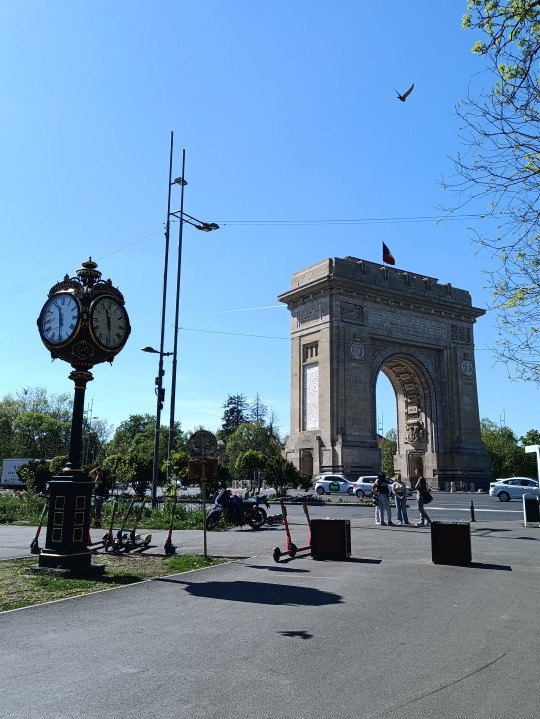






''Don't stop me now, I'm having such a good time''
#mine#personal#romania#bucharest#stavropoleos monastery#manastirii stavropoleos#palatul parlamentului#dimitrie gusti museum#palace of parliament#king mihai park#arcul de triumf#arc de triomphe#muzeul national de arta#national museum of romanian art#palace of the deposits and consignments#caru cu bere#ateneul roman#romanian athenaeum#vacations#travelling with friends#ρουμανία#βουκουρέστι
1 note
·
View note
Text
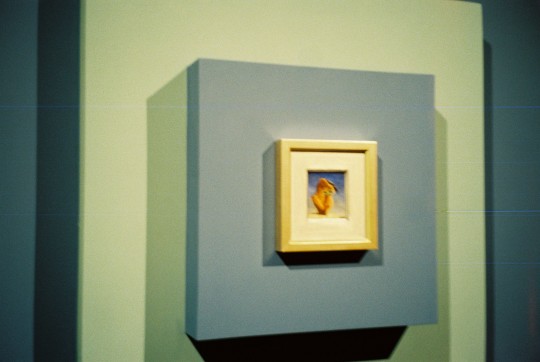
Kodak Ultramax 400
#35mm#painting#surreal#portrait#brauner#mnar#romanian art museum#national art museum#romania#bucuresti#bucharest
3 notes
·
View notes
Text
i remember being a wee bit nervously reluctant to use more monet motifs for anica just bc. well. his work is very popular and i am, if anything, a try-hard hipster at heart. then i remember how i had anica penned to be such a fan of impressionism movement and how that and heavy-duty francophilia have such strong sway on the romanian symbolist movement, modern romanian art founded by the heavily influenced grigorescu, who then inspired luchian. and then i think ‘fuck it this blog needs more monet’.
#tbd#romanian impressionism is just. it's so pretty.#i know i need to go back to the national art museum in september i gotta go back
4 notes
·
View notes
Photo
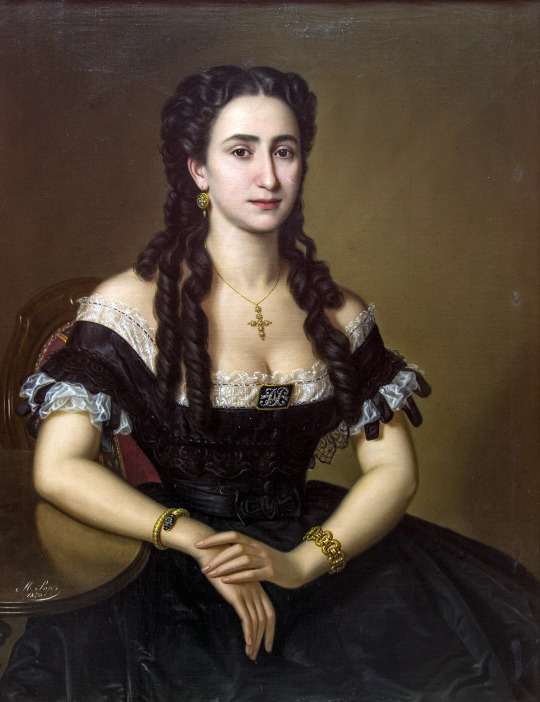
1870 Mişu Popp - Anastasia Rudeanu, actress, sister of actor Grigore Manolescu
(Romanian National Museum of Art)
1K notes
·
View notes
Text
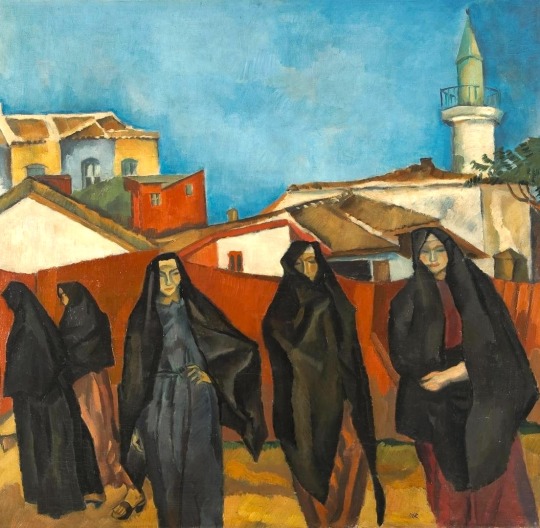
Dubroudgija landscape with five Turks, National Museum of Art, Bucharest, Romania - by Iosif Iser (1881 - 1958), Romanian
35 notes
·
View notes
Note
Hello! I believe you are Romanian?? Do you have any recommandations on what to see/do in Bucharest? (if you ever visited there??)
i am! and i have visited the capital quite a few times. i'm not an expert on Bucharest, since it's so big and there's so much to explore (i still have so much to see myself), but depending on how much time you have on your hands, here are some recs (and even a non-rec, you'll see lol):
the "Old Town", also known as "Centrul Vechi", there's some lovely belle epoque architecture, mixed in with some byzantine elements, west meets east kind of thing, really narrow detours and zig-zaggy alleys (you'll see this mixture throughout Bucharest: try the big, pretty boulevards like Calea Victoriei and Lipscani)
the Atheneum is also very pretty (near the Roman Square - "Piața Romană") and i'd also recommend the "Suțu Palace" (Palatul Suțu).
the "Village Museum" (Muzeul Satului), this really cool open-air museum all about traditional village life throughout the centuries in Romania, it's quite lovely
the National Art Museum (Muzeul Național De Artă) which is HUGE and wonderfully stocked, but you'll need like...almost a whole day to see all of it. the building is also really beautiful. if you have more time, you should also check out a smaller branch called "Muzeul Colecțiilor de Artă" (museum of art collections), where you'll find really interesting art donated by important Romanian families
definitely try to see the Stavropoleos Monastery, one of the oldest places in the city. it is a jewel. you'll love it there (and it's right next to the national history museum). if you visit Romania there will be no shortage of churches and monasteries to see. i'm def biased but we have some of the most beautiful monasteries in the world. you'll see a lot of cool churches/monasteries in Bucharest.
"Hanul Lui Manuc" (Manuc's Inn) is one of those big historical sites you should cover (and it's also a restaurant!); it's a very old inn going back to the beginning of the 19th century and some fascinating stuff went down between its walls (we were still under Ottoman rule when it was built, and it hosted an important peace treaty between the Ottomans and the Russians). i haven't dined there in ages, but i hear the food's still good!
you should check out some of the big parks like Cișmigiu and Herăstrau. there's also this tinier park i'm really fond of called IOR (also called Titan), but that's if you have more days to spare.
on that note, and because this is turning into an eclectic list, try to get to "Lacul Morii" if you can (literally the "mill lake"); it's this lovely and eerie lake that has this very 'abandoned Greek temple' feel to it, due to the architecture and the wilder vegetation on its one island/peninsula (called the island of angels). if you're into spooky/eerie vibes, i highly recommend it, since in order to engineer this lake, a church and a cemetery had to be demolished during the communist regime and uhhh, you definitely feel a vibe when you walk around that area.
speaking of communism, there will be plenty of museums and national houses that you can visit which will tell you about that era in Romanian history if you're interested, but err, you can see it as you walk around town; the eastern bloc soviet architecture is everywhere in the city planning and the grey apartment blocks. most towns in Romania have this overlapping architectural style and most of us have a hate/love relationship to it. since Bucharest is one of the safest capitals in Europe, you can explore neighborhoods and streets outside the big tourist centers, just to get a taste of that. you'll see really lavish streets, and then really industrial-looking, kinda grundgy areas and sometimes there will be combos of really old and really new, or really beautiful and really ugly. it has its own charm. don't stray too far tho
i'd recommend using the pretty good subway system to get to various places (buses and trams are usually super-packed and while there's not so much pickpocketing going on here as in, say, a much more touristy place like Rome, it helps to be vigilant). if you use the subway system, try to see the "Piața Romană" platform (in sector 1) because it's one of the strangest subway platforms in the world. it was basically built in secret during communism, because the dictator's wife didn't understand the purpose of that particular area having a subway line, and so the architects and engineers had to do a very hush-hush hatchet job, which resulted in a place with really narrow platforms and this unique look to it. it has those eerie/spooky vibes i love
DON'T, imo, waste your time on the Parliament Palace, infamously known as "Casa Poporului" (the people's house). you'll hear a lot about this building and how it's the second largest in the world, but it's an ugly behemoth that Ceaușescu had built out of mania and ego and the city and ppl suffered for it. it's the most ironic name you could give a parliament building. it's ugly and lame. skip it.
there are many other places to see, but last thing i'll mention here if you can swing it is the newly refurbished Marmorosch Blank Bank, which is now a hotel & restaurant. it's jaw-dropping, gorgeous kitsch and super bougie and expensive, but if you can look around it's worth it.
anyway, hope you have fun and that you get smth out of the experience! (don't worry about language hick-ups, btw, a lot of Romanians, especially younger ppl, know pretty good English)
16 notes
·
View notes
Note
Hello hello!! I saw your states post and was wondering if you can share with us your headcanons for New York or Texas, whichever one you feel more inclined to !! Thank you so much in advance! 😺💖💖
i'll post both since i have quite a bit on each ! so beware, this is gonna be a long post lmao
i'll go on about new york first because i have a lot on him dfghj. firstly, his human name is theodore douglass (he was given his first name by england, but chose his surname); he sometimes goes by theo, but only ever lets close friends call him teddy.
when he was a kid, theo was surprisingly shy, but very nerdy. he was a somewhat quiet child who loved to spend every waking moment reading and/or learning. england was actually kinda proud because of this, since new york could speak five languages by the time he was physically seven. he didn't really much else to do as a child, and was often left alone, so he would read and read and read.
nowadays, he's much prouder and loud, but still very, very nerdy. he can speak 31 languages fluently (outside of his indigenous languages), and is learning a further nine languages currently. he's fluent in english, spanish, cantonese, mandarin, russian, yiddish, haitian, italian, hawaiian, bengali, french, arabic, korean, hebrew, japanese, tagalog, hindi, polish, germany, greek, lithuanian, french creole, portuguese, urdu, ukrainian, swedish, norwegian, czech, finnish, danish and dutch fluently. he's reaching full fluency in afrikaans, and is currently learning slovenian, indonesian, samoan, romanian, swahili, yoruba, igbo and somali. he prides himself highly on his vast language fluency (nyc is actually one of, if not the most linguistically diverse city in the world !) and likes surprising the nations with their native language whenever he meets them. he knows more nations than any of the other states- he's actually friends with romano and lithuania ! he and romano have a mutual respect for each other, especially since new york was so eager to learn everything he could about italian culture while romano was living there, which romano appreciated.
he's also well educated outside of languages. he has a vast knowledge of art- from paintings and sculpture to dance, film, music and theater. he has a near encyclopedic knowledge on theater and plays. he has an extensive film collection of at least 25,000 films, and have an even bigger music collection- most of which he stores in his houses in nyc and manlius. he genuinely adores every field of art, and spends the majority of his time in nyc going to galleries, plays or art museums. his favorite areas of art are paintings, music and film. his favorite music genres would probably be classical, rap, r&b, hip hop and rock. he has a deep love for the rap and hip hop scene that was born out of nyc, and many of the artists that became major during the time are still his favorites.
he's also a very, very efficient worker; which is ironic, as he hates work. he's very fast and thorough in his work- if you want something done right, you go to him. not only is he good at paperwork and such, he's actually surprisingly good with his hands. he can repair cars, do home renovations, fix wiring, build furniture, make and mend clothing, hunt, fix machinery, knit, crochet and even farm. he's developed a vast number of skills over the years, and he loves learning more and more skills. he often busies himself with learning whatever new skills he can. he also often spends his time just tinkering with things for fun.
he also has a vast knowledge on fashion, and prides himself on his fashion sense. he's the most fashionable state out of all of them. he does usually dress very stylish and such, but he enjoys dressing in several different types of clothing, including punk, grunge and boho. he has quite a few walk-in closets, i'm sure, and has even made several of his outfits by hand.
he does have a bit of a superiority complex and is quite proud. he's generally pretty unphased and hard to surprise, as many nyc residents are. he's good friends with pennsylvania- they both have a love of machinery, tinkering and reading. they have occasional movie nights. he constantly argues with new jersey and massachusetts.
i also see him as being jewish, as new york state has the highest jewish population of any state.
now as for texas !
texas is very much a second alfred, minus the hero personality and plus a deep love of meat and meat-based dishes. he has a strong accent, one that he's very proud of. he's a very good cook, especially with meat-based dishes; he likes experimenting with meat and dishes in general. he's the older triplet to arizona and california, but ironically spends a lot of time fighting with california. he is, interestingly enough, quite good friends with florida- they both have loud, boisterous personalities and bond over being the 'weird' states. he's also, thanks to this, friends with ohio; the three have formed their own little club. he does typically get along well with his other state siblings (arizona, new mexico, nevada and utah). he's quite close to utah, as that's his only brother and he spent quite a bit of time with him when utah was young.
texas, in terms of personality, can absolutely be insufferable, obnoxious and loud at times; however, when he's hosting people he becomes a completely different person. he's a truly impeccable host; he'll cook several of his best dishes, extensively plan out activities and check in very regularly with his guests to ensure they're doing well and having a good time. he's insanely welcoming and hospitable, and is one of the best hosts of all the states.
he's also very similar to alfred in appearance- both in facial structure and hairstyle !! many have even remarked texas is basically a darker haired, dark skinned version of alfred.
#spider talks#statetalia#spider's statetalia#hetalia state ocs#aph new york#statetalia new york#aph texas#statetalia texas
10 notes
·
View notes
Photo


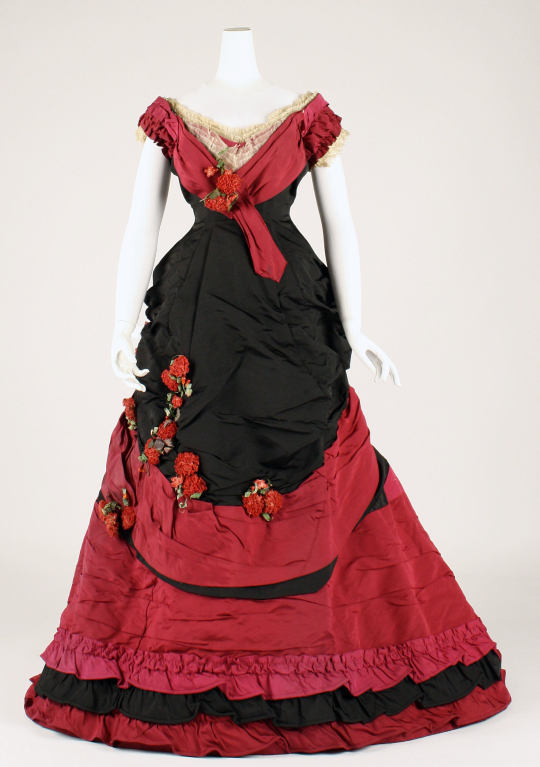
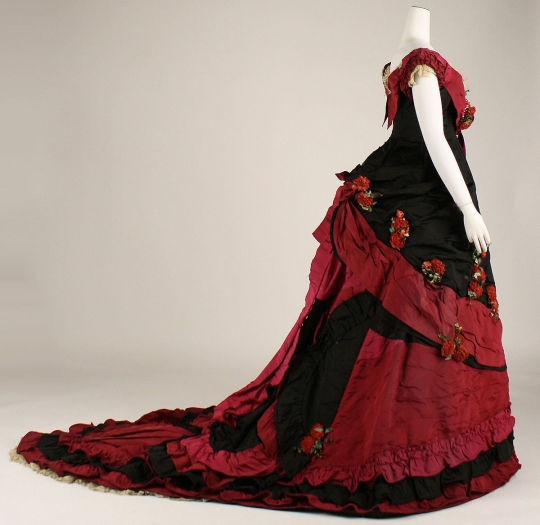
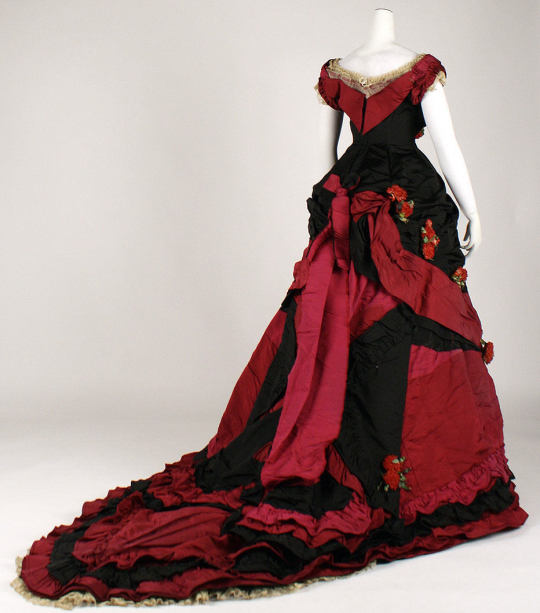
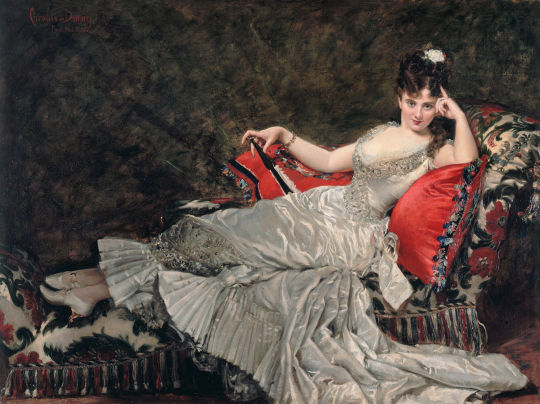
1870s Glamour -
Top 1870 Anastasia Rudeanu, actress, sister of actor Grigore Manolescu by Mişu Popp (Romanian National Museum of Art - Bucharest, Romania). From tumblr.com/the-perdita; fixed veiling reflections w Pshop 1735X2254 @72 1.5Mj.
Second row 1874 Young Woman by Heinrich von Angeli (location ?). From tumblr.com/lenkaastrelenkaa 950X1197 @72 721kj.
Third row:
Left 1870s (late) Front of dress by Elizabeth Marie Louise Jaeger worn by Princess of Wales Alexandra. From tumblr.com/sketches-a-la-mode 1661X2387 @72 546kj.
Middle 1870s (late) Side of dress by Elizabeth Marie Louise Jaeger worn by Princess of Wales Alexandra. From tumblr.com/sketches-a-la-mode 1200X1167 @72 272kj.
Right 1870s (late) Back of dress by Elizabeth Marie Louise Jaeger worn by Princess of Wales Alexandra. From tumblr.com/sketches-a-la-mode 932X1058 @72 230kj.
Fourth row 1876 Mademoiselle de Lancey by Carolus-Duran (location ?). From tumblr.com/toanunnery 1600X1196 @72 684kj.
#18770s fashion#late Victorian fashion#Anastasia Rudeanu#mişu popp#curly hair#bateau neckline#cap sleeves#Heinrich von Angeli#hair flowere#high V neckline#Queen Alexandra#Elizabeth Marie Louise Jaeger#hourglass silhouetts#V neckline#modesty piece#bustle#train#Mademoiselle de Lancey#Carolus-Duran#scoop décolletage#hair flowers#pleated frill#shoes
22 notes
·
View notes
Text
I woke up at 1pm. Housekeeping were banging on my door and I’d lost the morning. If I were to be professional I would say that I had jet lag. If I were to be honest, I had too many strawberry juices in the Old Town last night.
I walked the streets to find the closest thing to breakfast at 2pm and found a Starbucks. Making up for lost time I made my way to the Museum of National Art. Just outside the Old Town I stopped to admire a church. I decided to enter and was kindly welcomed in. I completed a questionnaire about trying to increase church tourism in Romania and explored the Orthodox Church for a while before striking up conversation with a lady volunteering and asked a few questions. She was more than happy to answer my questions and enlightened me on the history of religion in Romania. It turns out that most Christians in Romania are Greek Orthodox. Thinking about it, Greece isn’t that far away. The conversation was interesting but went on for an hour. An elderly lady who had come to pray was not happy about us speaking so loudly and said that she prayed for us or something of the like. Speaking quieter, I was educated on the history of the saints. Particularly focus was put on St Nicholas. Then the topic of music came up. At this point we left the church and stood on the steps, where she played me a hymn sung in Romanian on her phone and translated every line. The song lasted for 4 minutes and 44 seconds…We said our goodbyes and I made my way to the National Museum of Art. I learnt a lot about religion in Romania from our conversation and also discovered that most of the tourist attractions are located on one long road called Calea Victoriei.
Walking up Calea Victoriei, I discovered grand buildings from Bucharests golden era built in the late 19th and early 20th centuries. It felt like Budapest or Paris. Well, it turns out that many of the buildings in Bucharest are designed by a French architects or at the very least inspired by them. This is why it is referred to as Little Paris.
I made it to the National Museum of Art which was located in one of the grand buildings. There were two sections to it, Romanian Art and European Art. The exhibits were impressive and I enjoyed my visit but I am mainly interested in 20th Century art. The art on display was predominantly from the 16th and 17th centuries.
A short walk up the road I found the Romanian Athenaeum, a Neoclassical concert hall built in 1888. The interior was one of the most beautiful things that I have ever seen. I took my seat and enjoyed watching and listening to a youth orchestra rehearsing. The acoustics were amazing!
I made my way back to my hotel to freshen up for the evening and stopped off at Carrefour on my way. Placing most of my purchases in my small brown bag, I ended up setting the alarm off and being stopped by the security guard. How would I convince someone who didn’t speak English that I hadn’t been shoplifting. Thankfully I had a receipt. After a unnecessary momentarily panic the guard waved me on my way. I made my way back to my hotel where I freshened up for the evening.
The Old Town on a Friday and Saturday night is absolute carnage. Like many Eastern European cities, it is somewhat spoilt by the vast amount of stag parties who dominate the city at weekends. Nevertheless it is a fun night out. Most people were in large groups making it hard to break into, so it’s not the best location for a solo traveller, but it was fun.
In the early hours I strolled back to my hotel. As soon as you get outside the Old Town you realise that everyone is poorly maintained and falling apart. Newly bricked roads suddenly turn into quick sand whilst the gradient of the pavements ascends and descends with the elevation of Everest. A few steps from my hotel I tripped over an unstable paving block and fell straight down. The situation wasn’t helped by the lack of lighting. I lay on the floor for a while waiting for the ref to signal foal play, but justice didn’t arrive. My only comfort came from a lady further down the street who called to me “are you ok”. I was ok, but I had experienced the greatest fall in Bucharest since the fall of communism.
2 notes
·
View notes
Text

- i'll guide you down the stairs to our own ballroom -
Staircase in the Royal Palace of Bucharest, Romania (now the Romanian National Museum of Art)
4 notes
·
View notes
Text
Schengen Wonders: From Budapest to Bucharest with Roomchai Limited

Embark on an unforgettable journey through the heart of Eastern Europe, starting in the vibrant city of Budapest and ending in the historic streets of Bucharest. With the expertise of Roomchai Limited and other top Bangladeshi travel agencies like Obokash and ShareTrip, you can explore the wonders of the Schengen area with ease. Here’s a detailed guide to help you plan your trip.
Journey Overview
Starting your adventure from Dhaka, this trip covers two iconic capitals, each offering unique experiences. Roomchai Limited, along with Obokash and ShareTrip, provides packages that include flights, accommodations, and guided tours, ensuring a smooth and enriching journey.
Visa Requirements: For Bangladeshi passport holders, a Schengen visa is required. Roomchai Limited offers comprehensive visa support, making the process straightforward.
Stop 1: Budapest, Hungary
Getting There: Direct flights from Dhaka to Budapest take approximately 12 hours. Roomchai Limited often has great deals on flights, so keep an eye out for special offers.
Must-See Attractions:
Fisherman’s Bastion: Enjoy panoramic views of the city and the Danube River. This fairytale-like structure is a photographer’s paradise.
Heroes’ Square: Discover Hungary's rich history through impressive statues and monuments.
Central Market Hall: Explore local produce, souvenirs, and Hungarian delicacies.
Danube River Cruise: Experience Budapest’s stunning architecture from the water, especially beautiful at night.
Local Cuisine: Try traditional dishes like paprika chicken and dobos torte. Explore Budapest’s diverse food scene, from street food to fine dining.
Traveling to Bucharest
From Budapest, travel to Bucharest via train or a short flight. Trains offer breathtaking views of the Carpathian Mountains, making the journey an experience in itself.
Stop 2: Bucharest, Romania
Top Attractions:
The Arch of Triumph: A symbol of Romanian independence, perfect for a photo op.
Stavropoleos Monastery: A serene oasis in the bustling city, featuring beautiful Byzantine architecture.
National Museum of Art: Explore Romanian art from medieval to modern times.
Bucharest Botanical Garden: A peaceful retreat featuring a vast collection of plants and flowers.
Local Cuisine: Don’t miss out on ciorbă (sour soup) and cozonac (sweet bread). The city’s vibrant culinary scene offers both traditional and modern dining experiences.
Travel Tips
Currency: Hungary uses the Forint (HUF) and Romania uses the Leu (RON). It’s advisable to exchange currency in advance.
Language: While English is common in tourist areas, learning a few phrases in Hungarian and Romanian can enhance your interactions.
Transport: Both cities have excellent public transport systems. Consider purchasing transport passes for unlimited travel.
Why Choose Roomchai Limited?
Roomchai Limited offers tailored packages with a focus on Bangladeshi travelers, providing personalized service and attention to detail. Their packages often include unique experiences, making your journey memorable. While competitors like Obokash and ShareTrip also offer excellent services, Roomchai’s customer-centric approach sets them apart.
Conclusion
Exploring Eastern Europe’s hidden gems from Budapest to Bucharest is a captivating experience. With the help of Roomchai Limited, along with other top travel agencies, your journey will be seamless and unforgettable. Dive into the rich cultures, histories, and cuisines of these remarkable cities and create memories that will last a lifetime.
Book your adventure today with Roomchai Limited and discover the magic of Eastern Europe!
#RoomchaiLimited#EasternEurope#TravelGuide#BudapestToBucharest#ExploreEurope#BangladeshiTravelers#TravelWithRoomchai#SchengenVisa#DiscoverEurope#TravelFromDhaka#Budapest#Bucharest#TravelTips#EasternEuropeAdventure#TravelBlogger#BangladeshToEurope#RoomchaiTravel#ExploreWithRoomchai#TravelDiaries
0 notes
Text

ART | Brancusi at Center Pompidou
He is the inventor of modern sculpture. This exceptional retrospective takes you to discover the poetic universe of the sculptor of Romanian origin, Constantin Brancusi, around more than one hundred and twenty sculptures and four hundred works. At the heart of the exhibition: the identical reconstruction of his workshop, the historical matrix of all his creation.
Sculptures, photographs, drawings and films… the “Brancusi” retrospective offers the opportunity to discover all the dimensions of the creation of this immense artist considered the inventor of modern sculpture. At the same time a place of life, creation and contemplation, the artist's studio, jewel of the collection of the National Museum of Modern Art since its bequest in 1957, forms the matrix of this project. An exceptional set of sculptures, playing on the dialogue between the plasters of Atelier Brancusi and the originals in stone or bronze, loaned by numerous private and museum collections (Tate Modern, MoMA, Guggenheim, Philadelphia Museum of Art, The Art Institute of Chicago, Dallas Museum of Art, National Museum of Art of Romania, Craiova Art Museum…) are exceptionally brought together. The last Brancusi retrospective exhibition in France, and the only one, dates back to 1995 (curated by Margit Rowell at the Center Pompidou). A unique opportunity to discover this immense 20th century artist in a new light.
March 27 - Jul 1, 2024 Under the patronage of Mr. Emmanuel Macron, President of the Republic
0 notes
Text

ART | Brancusi at Center Pompidou
He is the inventor of modern sculpture. This exceptional retrospective takes you to discover the poetic universe of the sculptor of Romanian origin, Constantin Brancusi, around more than one hundred and twenty sculptures and four hundred works. At the heart of the exhibition: the identical reconstruction of his workshop, the historical matrix of all his creation.
Sculptures, photographs, drawings and films… the “Brancusi” retrospective offers the opportunity to discover all the dimensions of the creation of this immense artist considered the inventor of modern sculpture. At the same time a place of life, creation and contemplation, the artist's studio, jewel of the collection of the National Museum of Modern Art since its bequest in 1957, forms the matrix of this project. An exceptional set of sculptures, playing on the dialogue between the plasters of Atelier Brancusi and the originals in stone or bronze, loaned by numerous private and museum collections (Tate Modern, MoMA, Guggenheim, Philadelphia Museum of Art, The Art Institute of Chicago, Dallas Museum of Art, National Museum of Art of Romania, Craiova Art Museum…) are exceptionally brought together. The last Brancusi retrospective exhibition in France, and the only one, dates back to 1995 (curated by Margit Rowell at the Center Pompidou). A unique opportunity to discover this immense 20th century artist in a new light.
March 27 - Jul 1, 2024 Under the patronage of Mr. Emmanuel Macron, President of the Republic
0 notes
Photo

1852 Gheorghe Tattarescu - Portrait of Sofia Kretzulescu-Iacovenco
(Romanian National Museum of Art)
163 notes
·
View notes
Text

With excitement, I am thrilled to announce that I have been selected to exhibit a graphic work at the 20th National Art Biennial "Lascăr Vorel." This is a moment of great significance for me, and I can't wait to share this wonderful news with all of you!
The "Lascăr Vorel" Biennial is a benchmark event in the Romanian art world, and this year, we have the privilege of having the art historian and philosopher, Erwin Kessler, as the jury president. This gives me confidence that my artwork has potential and truly deserved to be selected for display in this prestigious setting.
Exhibition Dates: October 31, 2023 - January 9, 2024
Location: Piatra-Neamț Museum of Arts, 1 Piața Libertății Street, Piatra Neamț, Romania
The opening reception will take place on October 30th at 5:00 PM, and I warmly invite you to join. It will be a special moment to not only explore my artwork but also to discover the creations of other talented artists who will be present at the exhibition.

#artexhibition#romaniaart#conceptart#graphicart#art#darkart#darkartist#obscur#mystic#death#endoflife#bienal#symbolism
1 note
·
View note
Text
German Population Features and Statistics

Germany is a European powerhouse known for its rich history, cultural diversity and economic strength, and this article will explore the complexity of Germany's population, looking at its size, composition, trends and its uniqueness in a global context. Germany has a population of about 83 million .
Germany's population landscape
1. Population size and growth
Germany boasts a population of around 83 million and is the most populous country in the European Union. Despite the declining birth rate, the country's population remains relatively stable due to immigration. The table shows population trends in Germany in recent years, with 2021 shown as an estimate. Germany's population can fluctuate slightly over time, so it's best to check the current and accurate population with the official statistical office or relevant authorities.
yearPopulation (unit: million people)200082.18200582.44201081.75201582.18202083.02202183.16 (estimated)
2. Historical Perspective
A brief look at Germany's history highlights the impact of World War II and subsequent demographic fluctuations, including the partition and reunification of East and West Germany. These events had long-lasting effects on the country's population composition.
3. Population by city in Germany
Each of Germany's major cities has its own unique character and history, and represents the diversity of the country as a whole. Population data by major cities are shown below.
- Berlin
- Population: About 3.6 million
- Berlin is the capital and largest city of Germany and is famous for its diverse cultural and historical heritage.
- Hamburg
- Population: About 1.8 million
- Hamburg is an important port city located on the North Sea and the Elbe River, and has a great influence on its economy and trade.
- Munich
- Population: About 1.5 million
- Munich is the capital of Bavaria and plays a major role in culture, art and economy.
- Cologne
- Population: About 1 million
- Cologne is the capital city of North Rhine-Westphalia, famous for its cathedral and beer festival.
- frankfurt
- Population: About 7.5 million
- Frankfurt is famous as a financial centre, and is home to the European Central Bank and the European Stock Exchange.
- Stuttgart
- Population: About 6 million
- Stuttgart is a city of interest in the automotive industry and technology, as well as cultural activities.
- Leipzig
- Population: About 5 million
- Leipzig is a cultural and artistic center, rich in music festivals and museums.
- Dortmund
- Population: About 5 million
- Dortmund is a central industrial city with strong economic development and is well known to football fans.
German Diversity
3. Ethnic and cultural diversity
Germany is known as a multicultural society with a significant immigrant population. People from different backgrounds form the country's rich diversity, mixture of languages, cuisines and traditions that make it diverse.
The major ethnic groups in Germany include Germans, Turks, Italians, Poles, Syrians, Greeks, and Romanians.
Ethnic diversity is also increased by immigrants from various regions, including Africa, Asia, the Middle East, and Latin America.
Sure! The following table contains demographics of the main races in Germany. Please note that demographics for Germany can vary by year and survey method, the data below are based on rough estimates.
racePopulation rate (%)German76.9Turkish German2.8Polish German1.5Italian German1.3Russian German1.0Syrian German0.9other races and nationalities15.6
This table is a rough estimate; actual data may vary depending on official statistics provided by governments and census agencies. Germany is a multicultural society where people of different races and nationalities live together, and this diversity forms the country's rich cultural and social character.
4. Age distribution
A survey of age groups in Germany shows that the proportion of the elderly population continues to grow, posing unique challenges related to health care and social services.
Factors Affecting Population Trends
5. Birth rate
Falling birth rates have been a concern in Germany for years. We explore the factors contributing to this trend and the efforts governments are taking to encourage childbirth.
6. Immigration patterns
Germany has welcomed immigrants from various countries, especially in recent decades. The impact of immigration on population growth, economics and cultural dynamics is discussed.
Information on immigration demographics in Germany is as follows:
- immigrant population size
- Germany is a multicultural society with immigrants of various nationalities and backgrounds.
- The relatively high immigration population in recent years has increased Germany's diversity.
- country of origin
- Germany's main immigration destinations include Turkey, Italy, Poland, Syria, Greece and Romania.
- Immigrants are moving to Germany not only from European countries, but also from various regions such as Asia, the Middle East and Africa.
- purpose of immigration
- Immigrants come to Germany for a variety of reasons. Job search, family reunification, study, and refugee applications are the main immigration purposes.
- Immigrant population by city
- Germany's major cities, especially Berlin, Frankfurt, and Hamburg, are home to immigrants from many different nationalities, with a high level of cultural diversity.
- Refugees and persons of international protection
- Germany has adopted a welcoming policy for refugees and persons of international protection, and their numbers are steadily increasing.
- Social and Economic Participation of Immigrants
- Immigrants play an important role in Germany's society and economy, finding jobs in a variety of occupations and providing skills and labor.
- multicultural society
- Germany's growing immigrant population has created a multicultural society, showing diversity in various aspects such as various cultural events, food, language and art.
Germany's immigration demographics are constantly changing, with people of all nationalities and backgrounds starting a new life here.
Regional gap
7. Urban and rural population
Germany's population is concentrated in urban areas such as Berlin, Munich and Hamburg. The reasons for these urbanization trends and their impact on rural areas are analyzed.
8. Division of East and West
The reunification of East and West Germany made a difference in population density and economic development. We examine these regional gaps.
Social and Economic Impact
9. Labor force
Germany's demographic challenges intersect with labor demand. Explore the impact of an aging population on the labor market and potential solutions.
10. Medical and Elderly Care
With an aging population, medical and senior care services are gaining traction. We review policies to ensure quality care for seniors.
Conclusion
Finally, Germany has also played an important role historically and is now known for its strong economy and cultural diversity. It faces challenges such as a declining birth rate and an aging population, but it has a multicultural heritage and a strong economy.
Frequently Asked Questions (FAQs)
- What is the current population of Germany?
- According to current data, Germany has a population of around 83 million.
- What are the main reasons for Germany's low birth rate?
- Several factors contribute to Germany's low birth rate, including economic problems, work-family balance and high childcare costs.
- How has immigration affected Germany's population growth?
- Immigration has played an important role in maintaining population stability in Germany. This has contributed to economic growth and cultural diversity.
- What steps is the German government taking to respond to population challenges?
- The government is investing in health care and elderly care, along with policies to encourage family planning and immigration.
- What is the most populous city in Germany?
- Berlin, Hamburg and Munich are some of Germany's most populous cities and are known for their economic importance and cultural vitality.
Read the full article
0 notes